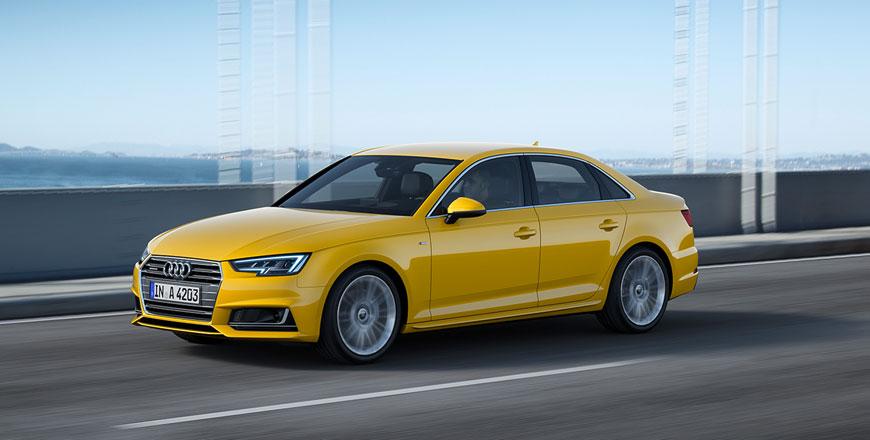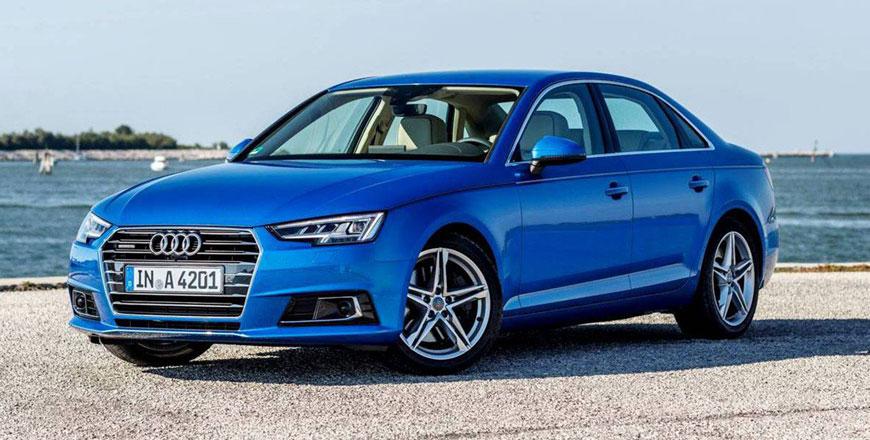You are here
Audi A4 2.0 TFSI Ultra S-Tronic: ‘Rightsized’ efficiency
By Ghaith Madadha - Apr 18,2016 - Last updated at Apr 18,2016

Photo courtesy of Audi
Launched globally at the Frankfurt Motorshow late last year and arriving in the Middle East market earlier this month, the latest generation Audi A4 is an all-new and thoroughly improved product. Refined and advanced, the new A4 is lighter, more dynamic and luxurious vehicle, and makes big strides in driver assistance and infotainment technology.
So far offered with choice of several petrol — and diesel options for Europe — the A4’s four petrol power models includes two high efficiency models, including the 2.0 TFSI Ultra. Sitting between the 148BHP 1.4 TFSI and 248BHP full-fat 2.0 TFSI, the 187BHP Ultra’s sophisticated combustion cycle delivers big engine low-end responses yet ekes out particularly frugal fuel efficiency.
Elegantly assertive
Slightly larger and roomier than its’ predecessor, the new A4 is nevertheless up to 120kg lighter — depending on model — owing mainly to increased aluminium content in its construction. The new A4 makes weight saving cuts in other components, including aluminium suspension, which reduces overall and unsprung mass, for enhances ride comfort, refinement and handling finesse.
Debuting a sharper and more assertive yet classy and somewhat understated design evolution for Audi’s saloon car range, the A4 features clean, crisp and defined lines and surfacing. However, its design character is dominated by an aggressively sophisticated hexagonal grille, which is flanked by slimmer more moodily browed and angular headlights with defined LED elements and big hungry lower air intakes.
With broad and tall grille and sculpted sills emphasising width and a sporty side, the A4’s sensible level waistline provides good visibility and an airy cabin, while a shorter front overhang and big footprint provide a confident road stance. With its design, mirrors, wheel wells and underbody covers smoothly managing airflow, the A4’s achieves best-in-class CD0.23 aerodynamics, depending on model and external variables.
Clever combustion
Powered by an innovative adapted Miller-cycle version of Audi’s 2.0 TFSI engine, the Ultra model uses what Audi terms “rightsizing” rather than downsizing to achieve efficiency and performance. With intake valves closing much earlier than usual and shorter compression and longer expansion phases, the Ultra only needs to compress as much as a 1.4 TFSI engine, but takes advantage of its larger displacement during its expansion phase.
Also featuring specially adapted combustion chambers, intake ducts, piston recesses and turbocharging to allow a short compression phase, the Ultra is designed to greatly enhance fuel efficiency and reduce emissions when driven at partial load — as car are most often driven. Meanwhile, fuel injection pressure is raised, while the engine’s valve-lift system also operates to ensure responsive power and torque delivery.
Clever and effective, the Ultra’s revised combustion method is combined with and electric turbocharger wastegate and exhaust manifold integrated in the cylinder head for optimised thermal management. Mated to a slick and responsive seven-speed dual clutch gearbox with reduced weight and friction, and automatic coasting ability, as well as stop/go city driving and efficient aerodynamics, the Ultra achieves frugal 5.3l/100km combined fuel efficiency.
Smooth and tidy
Developing 187BHP over 4200-6000rpm and 236lb/ft throughout 1450-4200rpm, the 2.0 TFSI Ultra is responsive and consistently muscular, with little turbo lag and a broad generous mid-range providing versatility and underwriting power accumulation. Dispatching the 0-100km/h dash in 7.3 seconds and capable of 240km/h, the Ultra features short low gears for responsive performance and tall higher gears for efficiency and refinement.
Front-driven with a low-mounted in-line engine and just ahead of equal length drive shafts, the A4 develops super off-the-line traction and well-suppresses torque-steer, which is also controlled by a brake-based torque vectoring system when taking tight corners with heavy and early throttle input. Considerably more agile and balanced than its front drive predecessors, the new A4 enhanced dynamics also benefit from a new light aluminium five-link suspension set-up.
With upper links directly integrated into bodywork for improved stiffness, the new A4 comfortably absorbs longitudinal forces and delivers sporty lateral stiffness. Nimbler and tidier than before, the new A4 tucks in crisply and also features responsive, precise and well-weighted electric-assisted steering. If slightly less nimble with the heavier torquier engine than the 1.4 TFSI, the 2.0 TFSI is offered with comfort or sports suspension with adaptive or fixed dampers.
Advanced assistance
Composed and taut through switchbacks and reassuringly stable, smooth and refined at speed, the driven A4 — riding on optional 245/40R18 tyres — had a good balance between supple rid comfort, grip and control through corners. Over imperfections and on rebound it felt settled. Elegant and ergonomic inside, the A4 offers an alert driving position, good visibility, excellent adjustability, decent space, quality leathhers and materials and an attractive user-friendly layout.
Extensively well-equipped with standard features and a long options list, the A4 is available with head’s up display a versatile configurable Virtual Cockpit instrument cluster screen. Optional equipment includes a Bang and Olufsen sound system and an 8.3-inch centre screen infotainment system upgrade, with voice control, smartphone integration, detachable rear seat tablets and a 3D navigation system able to operate in cooperation with safety and assistance systems.
Available with numerous advanced high-tech semi-autonomous and safety systems include the A4’s driver assistance suite includes Pre-sense City Safety, which can prevent collisions at 40km/h and mitigate severity to 85km/h. Additionally, its Tour package features radar-based adaptive cruise control, lane-keeping and traffic jam assist systems, which can even assume steering control on well-developed roads up to 65km/h, and can even anticipate and prepare for corners.
TECHNICAL SPECIFICATIONS
Engine: 2-litre, in-line turbocharged 4 cylinders
Bore x stroke: 82.5 x 92.8mm
Compression ratio: 11.7:1
Valve-train: 16-valve, DOHC, direct injection
Gearbox: 7-speed automated dual clutch, front-wheel drive
Power, BHP (PS) [kW]: 187.4 (190) [185.3] @4200-6000rpm
Specific power: 94.4BHP/litre
Power-to-weight: 133.3BHP/tonne
Torque, lb/ft (Nm): 236 (320) @1450-4200rpm
Specific torque: 161.3Nm/litre
Torque-to-weight: 227.7Nm/tonne
0-100km/h: 7.3 seconds
Top speed: 240km/h
Fuel consumption, urban/extra-urban/combined:
6.6/4.5/5.3-litres/100km*
CO2 emissions, combined: 119g/km*
Fuel capacity: 54 litres
Length: 4726mm
Width: 1842mm
Height: 1427mm
Wheelbase: 2820mm
Track, F/R: 1572/1555mm
Aerodynamic drag co-efficient: 0.23-0.27
Overhangs, F/R: 880/1026mm
Headroom, F/R: 1039/953mm
Luggage volume, min/max: 480/965 litres
Unladen weight: 1405kg
Steering: Electric-assisted rack & pinion
Turning circle: 11.5 metres
Suspension: Five-link, adaptive dampers
Brakes: Ventilated discs
Tyres: 245/40R19 (optional)
*As tested, with 18-inch wheels
Related Articles
Audi’s economy-minded petrol version of its prestigious executive saloon segment, it is testament to how things have changed that the A6 40
Among the most well-rounded cars in its class and winner of the Best Compact Premium Sedan segment at the 2017 Middle East Car of the Year a
Making its global debut weeks ago at the Frankfurt Motor Show and expected in Amman in early 2016, the new Audi A4 is the Ingolstadt-based f


















